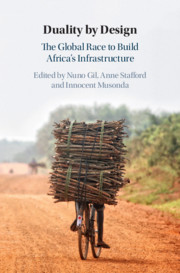Book contents
- Reviews
- Duality by Design
- Duality by Design
- Copyright page
- Contents
- Figures
- Tables
- Contributors
- Foreword
- Acknowledgements
- 1 Duality by Design: The Global Race to Build Africa’s Infrastructure
- Part I Mitigating Institutional Voids by Design
- 2 Why the Lights Went Out: A Capability Perspective on the Unintended Consequences of Sector Reform Processes
- 3 When the Quest for Electricity Reform and the Need for Investment Collide: South Africa, 1998–2004
- 4 Institutional Enablers of Energy System Transition: Lessons from Solar Photovoltaic Electricity in Eight African Countries
- 5 Harnessing Africa’s Energy Resources through Regional Infrastructure Projects
- 6 Centralized vs. Decentralized Generation in Zambia: Meeting Electricity Demand in the Context of Climate Change
- 7 Delivering Healthcare Infrastructure and Services through Public–Private Partnerships: The Lesotho Case
- 8 Achieving Long-Term Financial Sustainability in African Infrastructure Projects
- 9 A Proactive Social Infrastructure Model for Future Mixed-Use Housing in Egypt
- 10 Collective Action under the Shadow of Contractual Governance: The Case of a Participatory Approach to Upgrade Cairo’s ‘Garbage Cities’
- Part II Exploiting Institutional Voids by Design
- Afterword
- Index
- References
10 - Collective Action under the Shadow of Contractual Governance: The Case of a Participatory Approach to Upgrade Cairo’s ‘Garbage Cities’
from Part I - Mitigating Institutional Voids by Design
Published online by Cambridge University Press: 14 November 2019
- Reviews
- Duality by Design
- Duality by Design
- Copyright page
- Contents
- Figures
- Tables
- Contributors
- Foreword
- Acknowledgements
- 1 Duality by Design: The Global Race to Build Africa’s Infrastructure
- Part I Mitigating Institutional Voids by Design
- 2 Why the Lights Went Out: A Capability Perspective on the Unintended Consequences of Sector Reform Processes
- 3 When the Quest for Electricity Reform and the Need for Investment Collide: South Africa, 1998–2004
- 4 Institutional Enablers of Energy System Transition: Lessons from Solar Photovoltaic Electricity in Eight African Countries
- 5 Harnessing Africa’s Energy Resources through Regional Infrastructure Projects
- 6 Centralized vs. Decentralized Generation in Zambia: Meeting Electricity Demand in the Context of Climate Change
- 7 Delivering Healthcare Infrastructure and Services through Public–Private Partnerships: The Lesotho Case
- 8 Achieving Long-Term Financial Sustainability in African Infrastructure Projects
- 9 A Proactive Social Infrastructure Model for Future Mixed-Use Housing in Egypt
- 10 Collective Action under the Shadow of Contractual Governance: The Case of a Participatory Approach to Upgrade Cairo’s ‘Garbage Cities’
- Part II Exploiting Institutional Voids by Design
- Afterword
- Index
- References
Summary
The upgrading of informal urban areas is a pressing challenge for meeting the UN’s goal to make cities a pathway to sustainable development. Complicating co-ordinated collective action is the diffusion of decision-making authority and control over critical resources in a context where there is a shortfall of institutions. Tackling this grand challenge thus requires designing inter-organisational contexts capable of navigating many institutional voids, including ill-defined property rights, weak regulation and inefficient markets. In this chapter, we draw on a case study of a development project that granted decision rights to the poor to upgrade Cairo’s ‘garbage cities’ to further our understanding of this organisational challenge. Our aim is to illuminate a form of organising that is neglected in management scholarship. Its main attribute is the way by which contractual governance is supplemented with a consensus-oriented collective-action structure. Our main contribution is to theorise a trade-off central to this form of organising: collective action, under the shadow of contractual governance, economises on the high transaction costs that would otherwise be incurred to resolve ill-defined property rights. However, enfranchising the poor brings into the organisational boundaries the costs of collective action and risk of a tragedy of the commons.
- Type
- Chapter
- Information
- Duality by DesignThe Global Race to Build Africa's Infrastructure, pp. 284 - 312Publisher: Cambridge University PressPrint publication year: 2019

